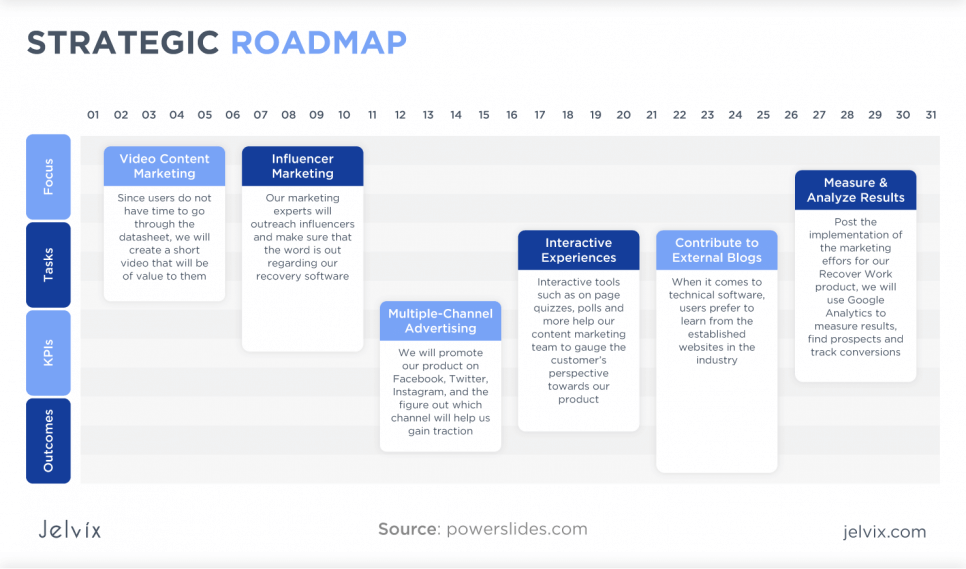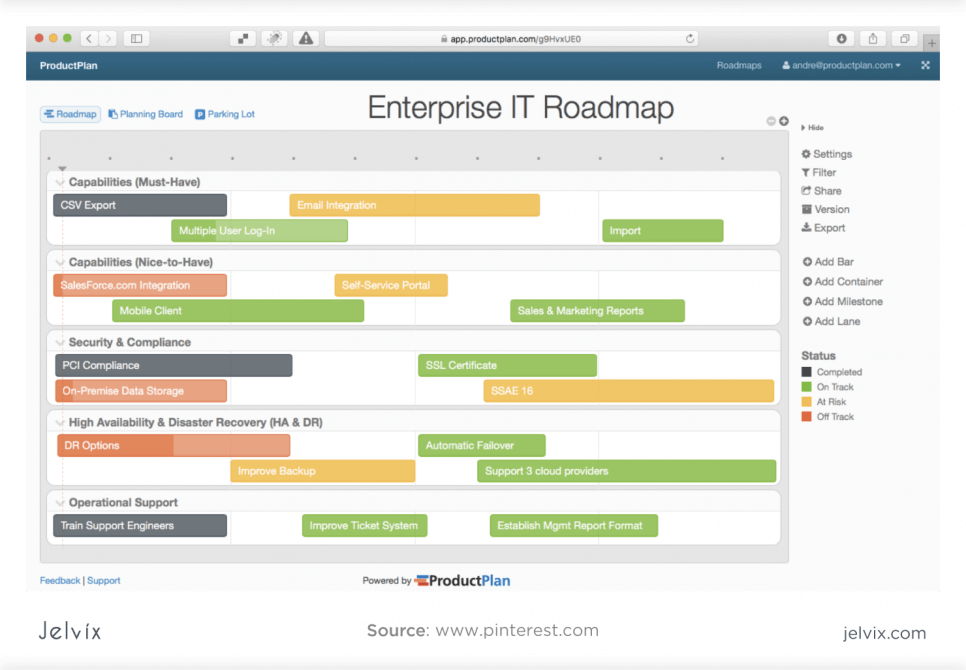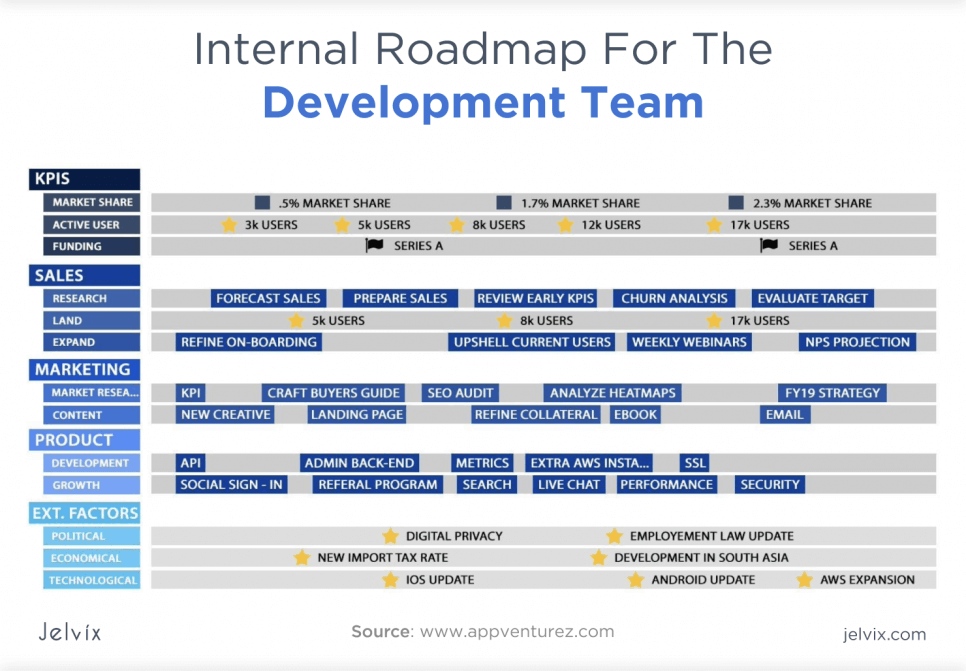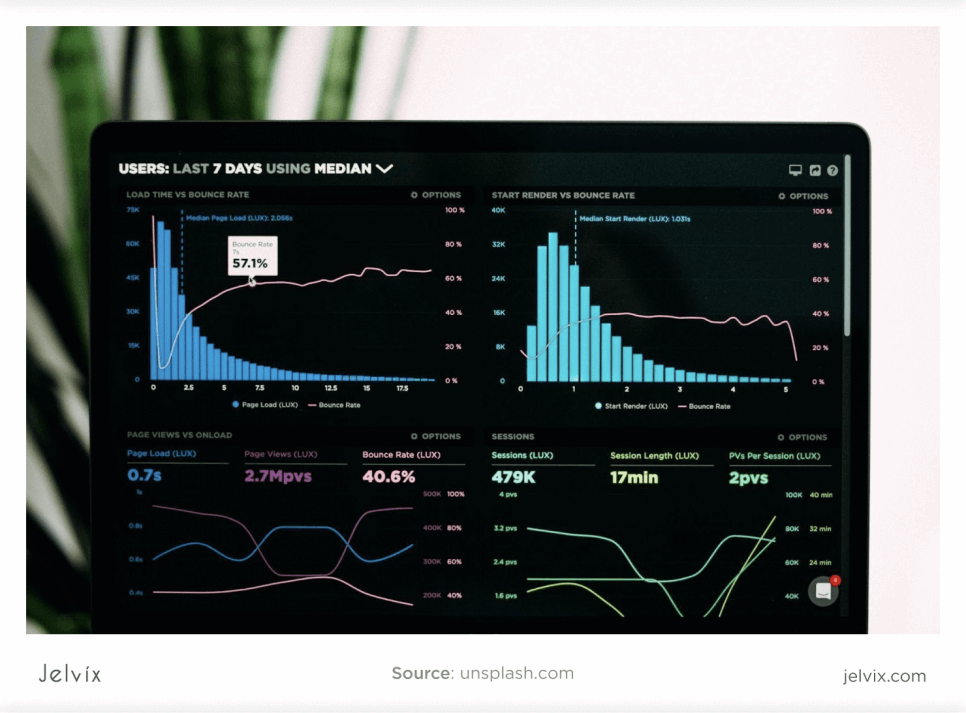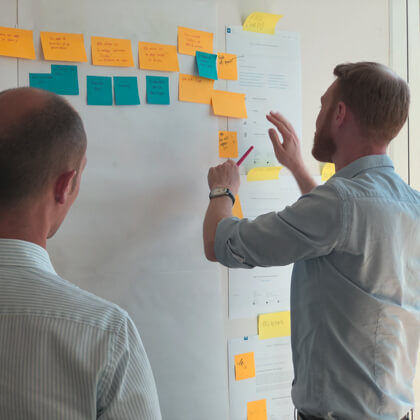Similarly to the mantra that says that you should never start a business without a business plan, you should never start developing a service or a product without a clear product roadmap. Although many would say that a product roadmap is not an essential element and that a well-organized team would be able to “organize themselves.”
However, the developmental path of a product you hope to launch is crucial enough to make you rethink the necessity of the roadmap.
What is a Roadmap?
A roadmap is a high-level document, be it physical or electronic, that outlines the stages of product development. The form of any roadmap is entirely to the product development manager to decide upon, based on the team’s preferences.
While some may enjoy a bullet-point list with deadlines and assignees, others may prefer a more visual approach. The latter definitely has its benefits: colors, sizes, and shapes add dimensions to a 2D sheet of paper and ensure that more information can be absorbed in a single glance.
A bad roadmap can signal product failure in the early stages of its development. However, with frequent revision and adjustment, a bad product roadmap can be turned into a roadmap that can increase the chances of success for your product or service.
The best example comes in the IT industry, where complex design and production processes yield success only to the best of the best. With a projected $4.66 trillion in IT spending in 2023, the world gets to choose, and they choose the best. 
The Goals of a Well-Developed Product Roadmap
To best understand how a successful roadmap is to be compiled, it should be noted that a successful roadmap should be able to satisfy the following five goals:
It should be descriptive, giving you details about the product development process – HOW the product is made and WHY the market needs it.
It should guide the executive bodies in the right direction. Having a good product roadmap should signal at all times what the current status is and WHERE the future steps should take it.
It should align the team members and aim their focus in a single direction. Every team member gets separate tasks and responsibilities, but keeping their focal point aligned TO the goal makes for a smoother development experience with fewer falls to the side.
It should facilitate further product development. All team members are gathered around a common set of tasks. Meetings (which should also be presented in the roadmap) can serve not as points of instruction but rather as points of facilitated rapport among the team members.
Having members from different fields working together opens up possibilities for a more interdisciplinary approach and may result in optimization and streamlining solutions never thought of before.
It should communicate the goals and future steps at any given moment. This function is a self-recurring one since the entire roadmap has the same goal. Here, the goal is taken from a more supra perspective to the paper or the screen itself.
In its digital form, the product roadmap can also contain links to backlog documents outlining specific steps to a certain goal. This way, the information related to any of the above-mentioned goals can easily be referenced without burdening the product roadmap with too much information. On the other hand, the ease of adjustments of a digital file can clearly reflect any changes in the goals of the product design process.
Product Roadmap Development
As we’ve mentioned before, a roadmap should not be too granular in its form. In fact, this is one of the most common reasons a product map fails. You should keep your roadmap as short and simple as possible to avoid too many changes, which can be entered into the specific backlogs.
This does not mean that a product roadmap is set in stone, quite on the contrary. As each step evolves and finishes and new insights are made, the product roadmap should evolve and change as well.
The changes made to the roadmap should have a holistic character. These changes should start from new findings in the field, such as those coming from the marketing team’s research. No subdomain changes should take place here. The supporting documents are there to absorb those fluctuations.
Yet, another kind of change that is usually made happens due to business disruptions. For example, because of the COVID-19 pandemic, as much as 41% of businesses in the USA suffered supply chain business disruption. Needless to say, many product roadmaps needed to be heavily adjusted since the supply and demand were both interrupted.
Furthermore, an additional stressor in the planned realization of roadmaps was switching to working from home. In this case, changing the support of the documents was a much better solution than changing the entire roadmap.
Learn more about the main stages of product development lifecycle to build a sustainable product.
Product Roadmap Types
There are as many product roadmap types as there are products, but we can outline a few general types:
Strategy Roadmap is a very high-level type of roadmap that outlines the basic tenets of a product, the WHATs, and WHYs of its development. It is usually presented combined with the market roadmap.
Market Roadmap investigates the market and presents a coherent plan on actions to take to develop the market needs. It is best used in specific niches and with a formed audience.
Visionary Roadmap can precede the other two, or it can follow them, depending on how developed the market is in the niche.
A Technology Roadmap is a detailed type of roadmap that takes into consideration more technical aspects of the project at hand; it is subordinate to product roadmap types 1 and 2.
The external Roadmap is aimed either at an outside audience or the internal staff, but only at the very beginning of the project. If it is done for an outside or external audience, it is presented with no deadlines and is seen as a plan for future steps, outlining the general direction that the company wants to move in.
If it is presented to the internal staff, some deadlines or time frames can be expected, but in general, it should prepare the team for the upcoming internal roadmap. External roadmaps are always designed with very loose time frames since it takes around 4 months just to put a product to the market once the design is complete.
Internal Roadmap – unlike external, this type of roadmap is not made public. This kind of roadmap has a mostly communicative purpose, as it is seen as a set of rough instructions from the executive part of the team. This form of a product roadmap is used as a sketch for other types of department-specific sets of instructions and backlogs.
Of course, there are more product roadmap types. Depending on the niche you’re in, you may have a separate roadmap for engineers or the research team. Understanding the function and the contents, rather than the form, is key to creating a successful product roadmap.
Roadmaps can be notoriously difficult and time-consuming to make. For that reason, not all of them are made at any given point. A strategy and an internal roadmap are a must in smaller teams and companies, while in larger companies, esp. international, more roadmaps are needed.
Product Roadmap Elements
Every roadmap made needs to contain several elements to serve all five functions outlined above:
- Goal
- Initiative
- Features
- Deadlines
- Progress Indicators
- Customer Satisfaction Indicators
The last element, customer satisfaction indicator(s), is not obligatory.
Goal
The goal is an integral and essential part of any product roadmap. A clearly defined goal will clearly outline what and why it is being done. A goal should not be mistaken for objectives – objectives are specific ways to approach a problem or specific cracks to be filled. A goal is a more general approach, and it offers a complete solution to a specific need or problem.
Initiative
While the goals present what should be done, initiatives describe how to get there. Initiatives represent the team, the funds, and resources, as well as the obligations and responsibilities of the team working on the product. While usually integrated, the initiative is also an integral part of a roadmap.
Features
A feature is like a semi-prototype of a product. This is the explanation about the tools, products, or services that will be used to deal with a specific market need.
Deadlines
Deadlines can be presented as simple time frames within which tasks are to be completed. In the early stages, while the team still discusses the resources and the time needed, deadlines can be rough (within a month, within six months, etc.)
Progress Indicators
Progress indicators should signal when specific parts of a roadmap have undergone a specific stage in their progress towards finalizing them. ‘In progress’ and ‘finished’ are not enough. If you were running a writing service, ‘to outline’, ‘to draft’, ‘to write’, ‘being written’, ‘to review draft’, ‘to finalize’ would be more appropriate progress indicators.
Customer Satisfaction Indicators
Customer satisfaction indicators are not an obligatory part of a product roadmap. While it may be necessary to run customer satisfaction in every product or service development, it does not have to be carried out since funds and time may be limited, and the market could be well known.
However, in step-by-step service roll out beta testing can be applied, and the results of customer satisfaction research can be used to further develop the product. This would also mean changing or expanding the existing roadmap.
Supporting Documents
As it has been stated, a product roadmap is a general set of implicit and explicit instructions that the executive level of a team comes up with to communicate, align, facilitate, describe and guide the project as it develops.
Needless to say, a roadmap is not enough. It is usually accompanied by a number of other documents that expand upon it and translate very general instructions into very specific and manageable steps.
Backlogs
Backlogs are very specific sets or lists of tasks to be undertaken so that every single step contained within the roadmap can be realized. These tasks can further branch into subtasks, depending on the project’s complexity and scope. As the tasks are finalized, one by one, the progress indicators of the roadmap are updated, and future steps are undertaken.
Release plan
A release plan is a tactical document that observes a group of tasks to be done for a successful release of a new product or service. It is a set of specific tasks and deadlines, but also of wait-events, which wait for specific signals from the market to initiate the next stage in the release.
These signals could be as simple as waiting for a specific holiday or a release date. They could be as complex as market influencing and research for the desired instilled traits in the market segment.
Release roadmap
A release roadmap is an executive type of release plan. Needless to say, the complexity of the product or service that is to be released dictates what kind of document will be used to follow the release itself.
While a release plan is a tactical document that follows a specific strategy, a release roadmap is there to guide the entire project of release. It is generally used in BETA version releases when a part of the product is withheld from the market until the bare-boned version is proven successful.
It is closely connected to the product roadmap, but it does not deal with what the product is and why it is made but rather listens to the market and tests consumers before releasing an updated version to a larger pool of customers.
Example of a product roadmap
In understanding the product development and release, investigating the market should be a prerequisite. This could be as simple as finding paper writing service reviews and having them do a part of the market research for you. While it may not be enough for your company’s needs, delegating a part of the research can save you a lot of time and resources on pilot programs and pilot studies.
Release Plan
Unlike the entire roadmap, which can span for months or even years into the future, with concrete, actionable steps to undertake, a release plan is an internal document referring to a specific part of the entire road from designing to marketing a product. It answers the question of ‘what’ to do instead of ‘why’ and ‘how’ to do it. It takes the strategy and converts it into concrete steps based on the specifics of your product.
Sprint Plan
A sprint plan is a short-term plan consisting of actionable steps that you can undertake to complete a large set of tasks that should result in a chunk of your product being finished and ready to present to the coordinators of the entire project.
During this time, the backlog of tasks is taken care of, and the product design and marketing processes are streamlined to ensure more efficient work. As the name suggests, a spring plan is a plan of quick steps that achieve a lot in a short period of time.
Now-next-later roadmap
The now-next-later roadmap is mostly used when communicating with a larger audience and when communicating broad plans without too many details or deadlines. In some cases, it can happen that this type of roadmap is confused with a simple calendar of events, although the differences are striking.
The now-next-later delineation refers either to a general logical succession of steps or to the urgency of a multitude of tasks at hand.
Kanban roadmap
The Kanban roadmap is a common type of roadmap for the simplicity of its design and the amount of information it presents you with. The map includes ‘buckets’ with to-do, in-progress, and finished concrete tasks in a simple, easy-to-understand outlay. Another dimension of either ‘urgency’ or ‘the team assigned’ can be added to present even more relevant information.
Final Considerations
Roadmaps are an essential part of doing business nowadays. Sometimes they are expensive and time-consuming, the very notion of the benefits and level of organization that is to be acquired defeats any costs that may arise from them.
Although very general, roadmaps are often divided into subsections, and each should be limited in terms of time and resources dedicated to it.
Although budget may not be a problem for a larger company, in a startup, having to spare a little budget can be quite helpful. Furthermore, each section of a roadmap is a new opportunity to gain much-needed experience.
If you want to overcome your competitors, feel free to reach our specialists. We will help you build a product vision and overall product strategy that will satisfy all your demands and needs.
Nicole Garrison is the operations manager at a company specializing in the best paper writing service reviews. She enjoys every moment of her job. Her secret is a systematized, step-by-step approach to automating and delegating her responsibilities.
Need a qualified team of developers?
Scale your development capacity with top-level expertise and resources.




